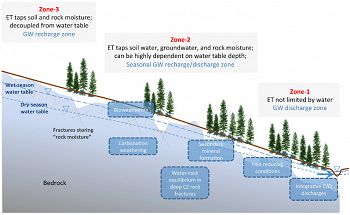Brooks et al., 2015
Hydrological partitioning in the critical zone: Recent advances and opportunities for developing transferable understanding of water cycle dynamics
Brooks P.D., Chorover J., Fan Y., Godsey S.E., Maxwell R.M., McNamara J.P., and Tague C. (2015)
Water Resources Research 51 (9): 6973-6987 Cross-CZO
-
Catalina-Jemez, INVESTIGATOR
-
Catalina-Jemez, INVESTIGATOR
-
Reynolds, INVESTIGATOR
-
Reynolds, COLLABORATOR
-
Sierra, INVESTIGATOR
Plain English Summary
Observations in the critical zone, a multi-disciplinary system extending from the top of forest canopy to the base of groundwater, provide an opportunity to increase understanding of the amount, routing, and timing of water flow from the stages of precipitation to groundwater, and how these hydrologic processes influence and are influenced by other biological, geological, atmospheric, and physical processes.
Abstract
Conceptual model showing relationships between three zones of groundwater depth, associated subsurface biogeochemical reactions, and surface vegetation expression.
Hydrology is an integrative discipline linking the broad array of water-related research with physical, ecological, and social sciences. The increasing breadth of hydrological research, often where subdisciplines of hydrology partner with related sciences, reflects the central importance of water to environmental science, while highlighting the fractured nature of the discipline itself. This lack of coordination among hydrologic subdisciplines has hindered the development of hydrologic theory and integrated models capable of predicting hydrologic partitioning across time and space. The recent development of the concept of the critical zone (CZ), an open system extending from the top of the canopy to the base of groundwater, brings together multiple hydrological subdisciplines with related physical and ecological sciences. Observations obtained by CZ researchers provide a diverse range of complementary process and structural data to evaluate both conceptual and numerical models. Consequently, a cross-site focus on “critical zone hydrology” has potential to advance the discipline of hydrology and to facilitate the transition of CZ observatories into a research network with immediate societal relevance. Here we review recent work in catchment hydrology and hydrochemistry, hydrogeology, and ecohydrology that highlights a common knowledge gap in how precipitation is partitioned in the critical zone: “how is the amount, routing, and residence time of water in the subsurface related to the biogeophysical structure of the CZ?” Addressing this question will require coordination among hydrologic subdisciplines and interfacing sciences, and catalyze rapid progress in understanding current CZ structure and predicting how climate and land cover changes will affect hydrologic partitioning.
Citation
Brooks P.D., Chorover J., Fan Y., Godsey S.E., Maxwell R.M., McNamara J.P., and Tague C. (2015): Hydrological partitioning in the critical zone: Recent advances and opportunities for developing transferable understanding of water cycle dynamics. Water Resources Research 51 (9): 6973-6987. DOI: 10.1002/2015WR017039
 This Paper/Book acknowledges NSF CZO grant support.
This Paper/Book acknowledges NSF CZO grant support.
Explore Further






